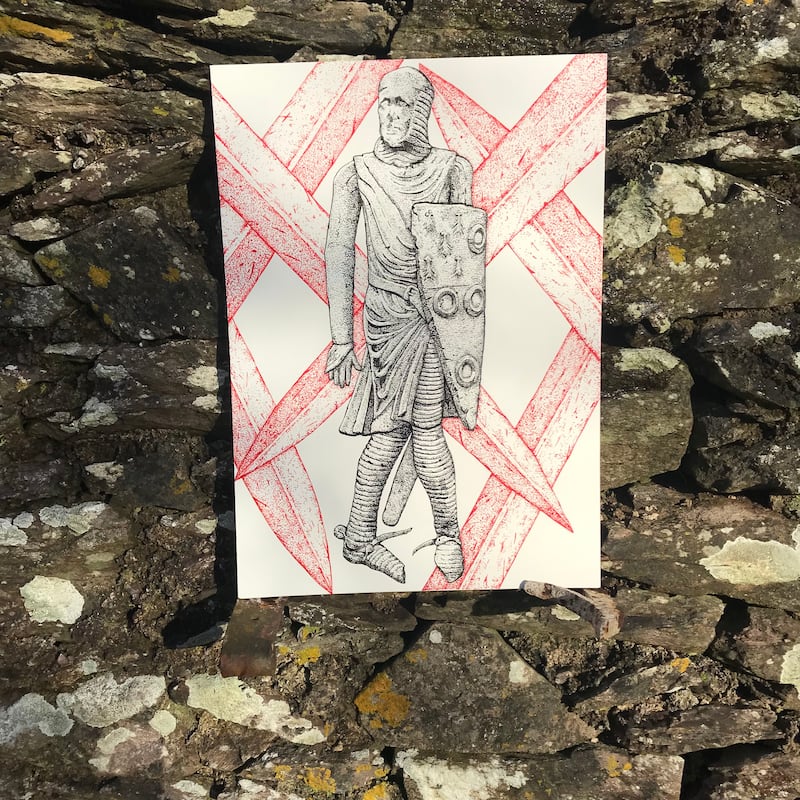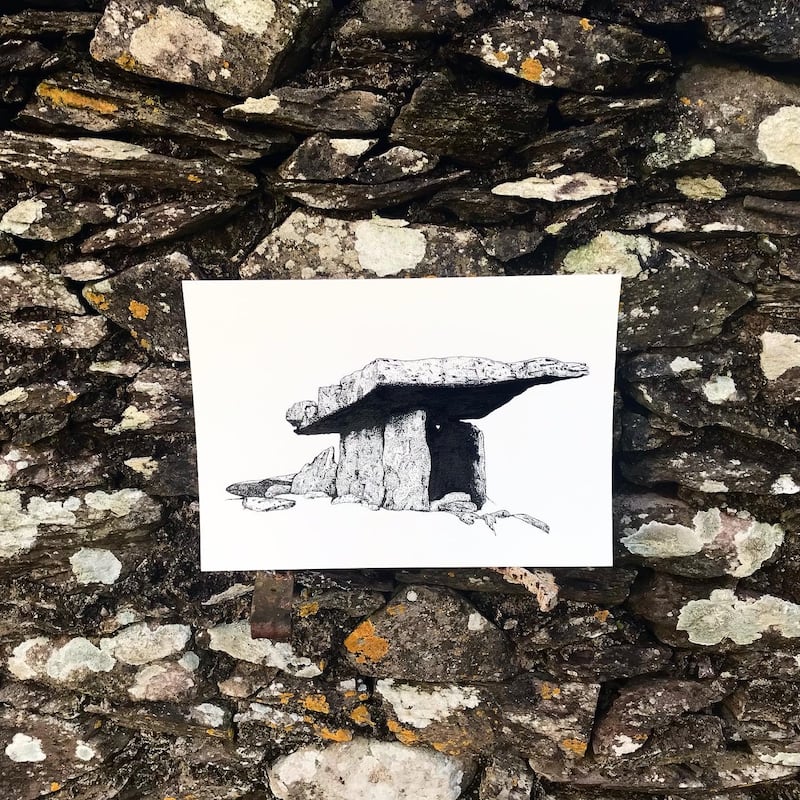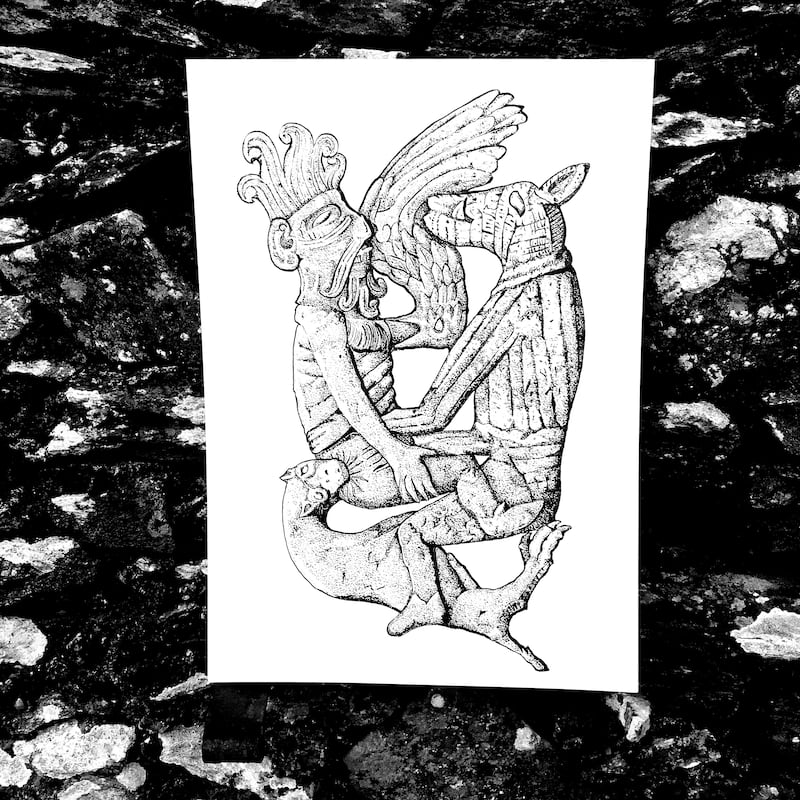This month the artist John Flynn presents an exhibition of his remarkable stone drawings in Cork. For more than half a decade Flynn has been illustrating Irish stones, neolithic sites, and stone carvings in a style called stippling, drawing small dots to create patterns that bring the stones to life. His drawings include Poulnabrone dolmen, in the Burren, the Viking graves of Killegar Church, in Co Wicklow, sheela-na-gigs, and the ogham stones of Mayo.
Stippling is an arduous process, sometimes requiring hours to complete a few centimetres of work. “It’s all been completely natural,” Flynn says of his practice. “I’d be reading stuff in books, looking for stone circles; there might be one up the road. Me and my wife, Becky, we’d go for a spin on the days off we’d have, go for a coffee, go see the stones, and since then I think I’ve dragged her to more wet fields than anything.”
The result of his practice, while (often literally) underground, is gaining a solid fandom. His drawings marry the ancient and the contemporary, the organic and the highly technical. Sometimes it’s as though the stones he draws are alive, markers of ancient time, brimming with stories.

Flynn took a fine-art degree at Crawford College of Art & Design, but he emerged into “a harsh reality. That reality is, there’s a lot of grind. The world is not as nice to artists as you’re led to believe.” He found himself creating work he thought would be successful, but it fell a little flat. “I was forcing myself to do what I thought people wanted to see: nice, safe images; easy work.” But when he began to draw Irish animals, and to post the results to social media, “people were loving it”. Requests for prints rolled in, and he kept working. “The support from my mum, Nora, from day one was key to my passion and success,” says Flynn. He cites influences that include the artists Diabhal, Aoife Tierney, Glyn Smyth, Kate O’Neill and Hugh Cooney.
READ MORE
When he began to create illustrations of stones – “a really natural, fun progression, just my own interest” – he realised “the more interest I have in something, the more people are interested in it”. In 2018 he began working with ink in earnest, in the stippling style with dipping ink. “I use basic Indian ink, black ink and nibs and nib-holders. I just call it a pen. It’s laborious, but it’s an old style. They’re modelled on quills. I have some bamboo sticks, and reeds cut from the bog near home. It’s long hours, but there’s an out-of-body thing that happens where you’re almost working with the stone.” In many ways Flynn is continuing the lineage of old Irish scribes. “My poor finger is bent,” he says.
Initially unsure what led him to have such a connection with Irish stones and stone carvings, Flynn came to realise that their influence was right in front of him all along. “I grew up in Macroom. My family house is underneath Macroom Castle. Out our back garden is its monster skeleton. When I show people the house, they say, ‘No wonder you’re obsessed with this stuff.’ I didn’t even see it when I was small. But it all makes sense in the subconscious.”

His projects include Irish Cave Bones and Viking Dublin Dogs, working with Dr Ruth Carden, a paleozoologist and research scientist at University College Dublin’s school of archaeology. (“She is fantastic,” he says.) At one point, working on the cave project, he found himself deep underground, in a pitch-black cave, exchanging business cards with a photographer. The cave project, he says, is about “going very far back in time ... These people and these animals in the past, they lived lives, and these lives should be expressed.” When “heaps of wolf bones” were found during a dig in Dublin, his illustrations became part of the Viking Dublin Dogs project. “The Vikings in Dublin had pet wolves,” he says. “So there is a story there of the merging of the wolf and the dog. This isn’t fantasy. These were real people and real animals.”
A place of particular interest to Flynn is Scotia’s Grave, near Tralee in Co Kerry, which is said to be the burial place of a queen killed by the Tuatha dé Danann, “I went down there years ago. Bury me down there in the bog!” Certain counties have a particular pull, he says. “Sligo. Jesus, if there was one county you could move to, the amount of stuff there. Queen Medb’s cairn is an epic on its own.” But his process of journeying to various places is less strategic and more organic. “I generally love seeing a place and taking it in, in all its form. And if we cross paths again, we cross paths again.”
He is now close to having completed “a couple of thousand” drawings of stones. Another entity that thrills him is Digital Heritage Age, a project founded by Gary Dempsey and Orla-Peach Power, who use digital tools to preserve, protect and promote cultural heritage. The project includes cataloguing sheela-na-gig carvings in Ireland, using photogrammetry and laser scanning.

Flynn’s “bread and butter” is painting and illustrating hurleys. “Again, they’re one of the most natural things that’s ever been beside me,” he says. “I was doing a lot of work with acrylic wood paint, painting frames, and I just had tubs of this expensive wood paint. One of the lads who’s a big hurler suggested I painted on a hurley. I painted two hurleys, a fox and a badger. It just caught on. People connect with it. I think I’ve painted over 300 at this stage. I had one person buried with one of them. I’ve had hurleys done for ambassadors. I walked into a pub once and there was one of my hurls just hanging there. Just like the stones, it’s a simple thing. People gravitate towards them. It’s all just connecting with things in nice, natural ways.”
Flynn emphasises the importance of recognising, appreciating and preserving our cultural heritage. “This stuff matters. Culture is so important. What I do has nothing to do with national-pride nonsense. It’s about embracing culture. When you see the sun come through Newgrange, that makes me cry every time. What’s that about? It’s about connection. You can see a carving on a lump of a stone, and you feel something. It’s so deep-rooted ... You have to sit back with the stones, with the stippling. It allows you to slow down a lot more.”
John Flynn’s exhibition Stones of Ireland and Local Stones is at Art on Main Street, in Macroom, Co Cork, until the end of February

















